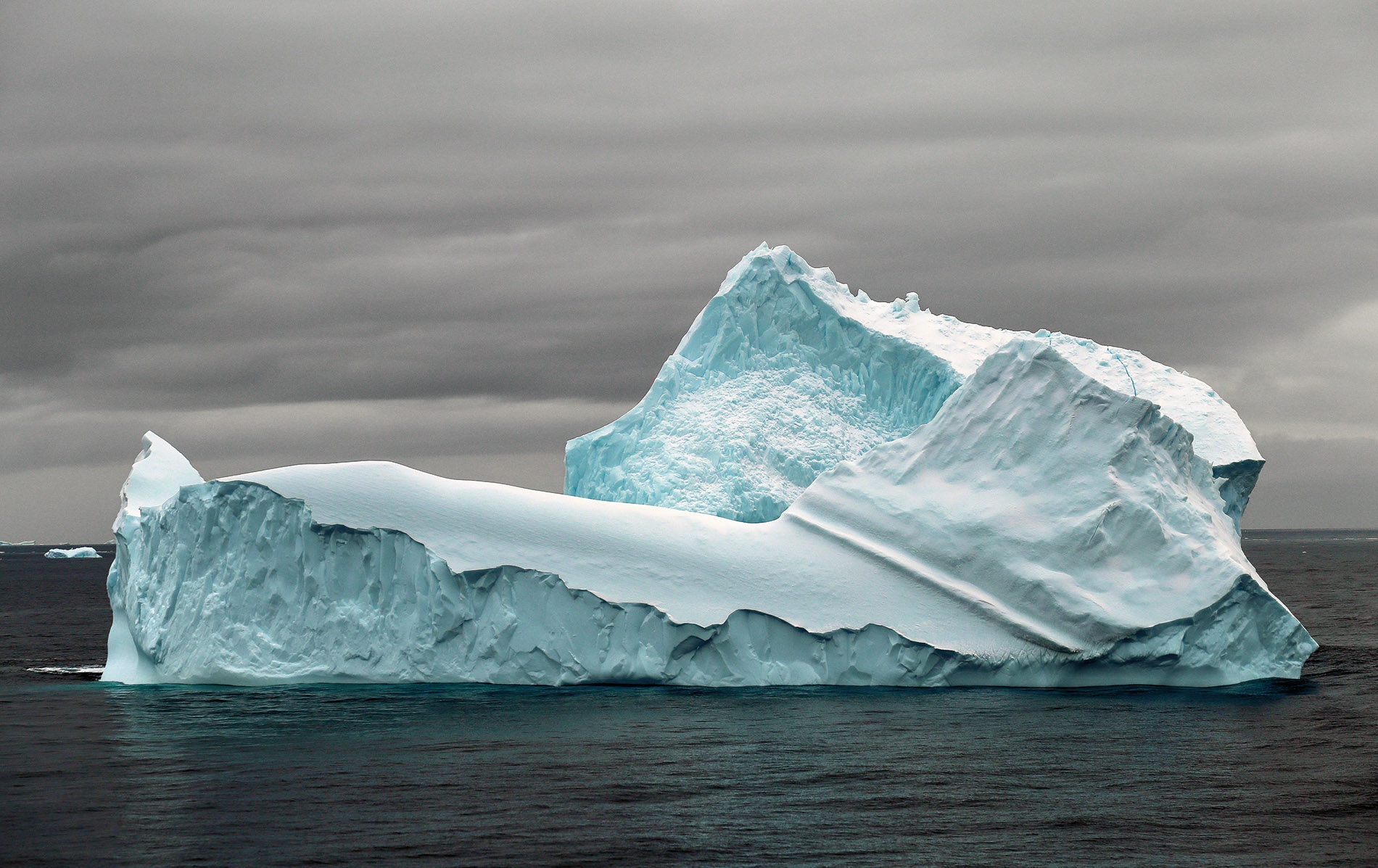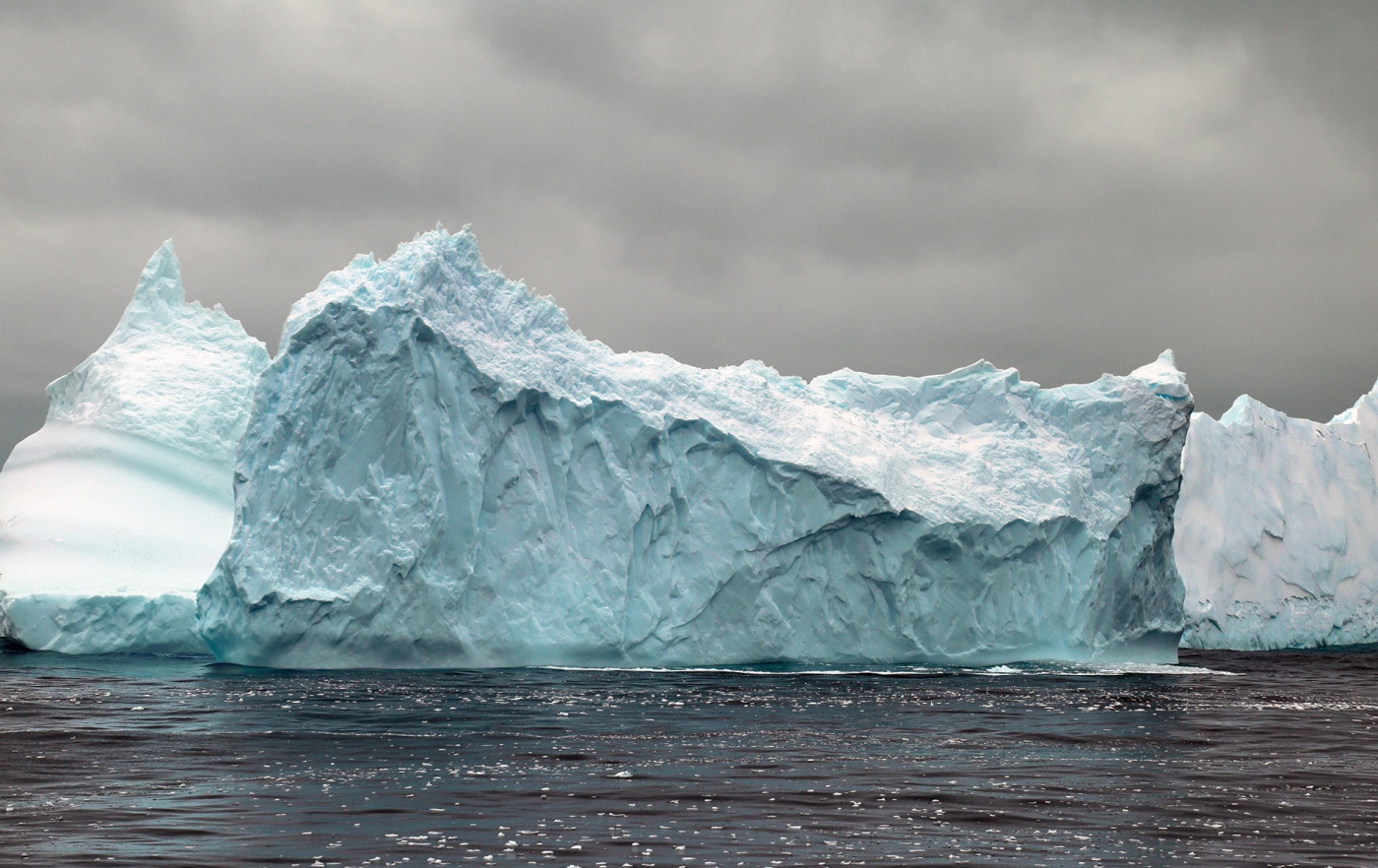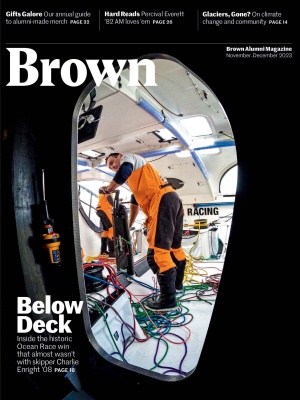
Ice-Breaker
As glaciers collapse, a community comes together.
It’s a sunny Sunday morning when the Nathaniel B. Palmer sails into an unnamed bay on the west side of Antarctica. Elizabeth Rush looks out into the inlet. Heaped together like mountain ridges, towering lavender icebergs litter the once open water. They’re positioned near the western front of Thwaites Glacier, where the icebergs, numerous and glossy, have since splintered into fragments. Thwaites—the widest glacier in the world—is disassembling at a rapid, unprecedented rate. And Rush, a Pulitzer Prize–nominated author and a Brown professor of English, has come to witness the breakage.
This is nothing like what I expected, Rush will later write. As she explains in The Quickening, her book published this August, the recently calved icebergs are evidence of a massive ice shelf collapse happening all around them. But the morning is still. There is no unruly blast of spray, no wild gush of water.
At the bottom of the world, Rush turns to her companions aboard the Palmer. The 57 scientists and crew members working on the 94-meter research vessel lend Rush their voices, their research, their stories; through her, they tell us what she could not discern alone. “Through their eyes, I could see the difference,” she tells me: The glacier looks sick. Mangled. Gnarly.
Bearing witness to such collapse, Rush wonders, how could something not shift?
The Palmer and its passengers have come to study the impacts of climate change. But their testimony from the ice grants us something more: the provisional community they form is itself a gentle promise. A roadmap, perhaps.
Waters rising
The Quickening details Rush’s 52-day research cruise to Antarctica, chronicling the Palmer’s voyage from Punta Arenas, Chile, to Antarctica’s Amundsen Sea. In her previous book, Rising, a finalist for the Pulitzer Prize in creative nonfiction, Rush documents rising sea levels as they impact communities across the U.S. coastline. In The Quickening, she investigates this rising at the source.
Nicknamed the Doomsday Glacier, Thwaites alone contains enough ice to raise global sea levels by two feet. Should we lose Thwaites completely, the entire West Antarctic ice sheet could become unstabilized, causing sea levels to rise by another ten feet or more. These are just informed predictions. Before the Palmer’s international research team arrived in the winter of 2019, no human had visited the glacier’s calving edge.
Rush’s approach to storytelling dramatically reimagines how we’re conditioned to think about climate change. The narratives we so often rely on, Rush explains, tend to center around the triumphs of individuals, rather than systemic change and adaptation.
Antarctica is a perennial example. While applying for the National Science Foundation’s Antarctic Writers and Artists Program, the grant that later facilitated her journey aboard the Palmer, Rush sifted through books of Antarctic history. Their pages recounted a formulaic timeline of famous expeditions. Their descriptions, dominated by white, male, and singular perspectives, described the ice in similar terms: desolate, barren, conquerable.

Voices unheard
Rush’s narrative stands to rectify this history, integrating stories of community and regeneration into the Antarctic canon. Her own path to motherhood provides the book’s narrative arc, as she chooses to delay pregnancy in order to attend the cruise (pregnant people are not allowed on the ice) and ultimately gives birth to her son in the earliest days of the pandemic. “I think of this book as a secret feminist rewriting of Antarctic history,” she says.
Rush conducted 213 interviews with her shipmates. Through their voices, Rush delivers perspectives from those historically excluded from the ice or written out of the archive—those from women and people of color, from cooks, mothers, and technicians. “Their words are all over this project,” Rush says. “I think the poetry in the pages is really theirs.”
Antarctic explorers have long sought to subjugate the continent. But unlike their predecessors, the Palmer and its passengers take their cues from the ice itself: by learning Thwaites’s signals, they seek to measure mankind’s impact. Calving is a natural form of ice disruption, Aleksandra, Rush’s shipmate, explains. The rate at which it’s currently happening, however, is not. Antarctica is experiencing a quickening, its glaciers coming alive as they swiftly break apart. And with global temperatures only continuing to rise, we confront an increasingly unpredictable future. Rush and I speak towards the end of the hottest summer ever recorded.
Throughout the book, Rush stays driven by hope, even as the glaciers around her fracture. “I think hope is action,” Rush explains. With only a limited amount of time to gather data on the cruise, Rush assists her shipmates digging for penguin bones on the rocky shoreline and helps label samples of dirt exhumed from the ocean floor. “There is a sense of accountability.”
Discussions of climate change have long focused on individual actions—which light bulb or electric car to buy, whether or not to have children—but this misses the bigger picture, Rush says. True climate resilience is forged through shared effort; by 57 strangers ignited by a common mission.
Earth changing
“To Nico and Nana,” Rush says, gesturing to the front row. Rush’s son and mother, to whom the book is dedicated, sit beside her husband and father on the outdoor patio at Glou bar in Fox Point. I sit surrounded by fellow Brown students, faculty, and neighbors gathered to celebrate The Quickening’s release.
Four years after her return, Rush remains in touch with just a few of her former shipmates. The community she found aboard didn’t last long after the Palmer returned to shore.
“Community can really coalesce around a shared set of goals,” Rush later tells me—it does not exist in perpetuity. But this means that it can form anywhere, even in small or familiar places.
On the warm August evening, the crowd listens as Rush recalls her journey to the bottom of our rapidly shifting planet. Much like the team aboard the Palmer, everyone here has come for a similar reason: to observe, to learn, to listen. The sun is nearly setting when the Providence crowd turns its attention to a stack of grocery store sheet cakes. I look around the cramped, fairy-lit patio. Maybe there is a quickening here as well.





